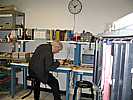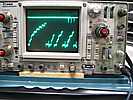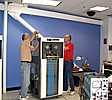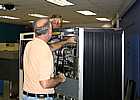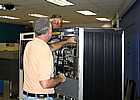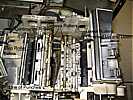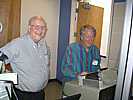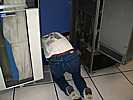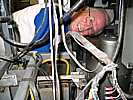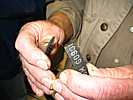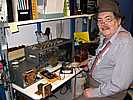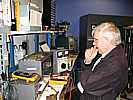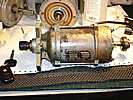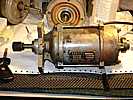Schedule April 2006
return to main 1401 Restoration Page
go to May 2006
go to Team Bios
Contents:
Wednesday April 5th - general, Thursday April 6th - TAU Team
Saturday April 8th - general
Wednesday April 12th - general, Thursday April 13th - TAU Team,
Saturday April 15th
Wednesday April 19th - general, Thursday April 20th - TAU Team
Saturday April 22nd - general
Wednesday April 26th - general, Thursday April 27th - TAU Team
- Wednesday April 5th - 10 AM - Roll up sleeves -
- We had Allen Palmer (back from Paris;-), Robert Garner (back from the eclipse in Turkey), Grant Saviers (back from the over stocked surplus warehouse;-)), Glenn Lea, Chuck Kantmann, Bob Crane, Frank King (well tanned from somewhere), Ron Williams (back from a prank?), Ed Thelen (back).
- Grant brought in a lap top - to be permanently resident (green card). Santa also brought in a 11x17 inch scanner and Palm organizer. The card storage cabinets are held ransom by the current wet weather.
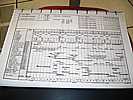
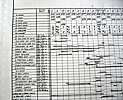
This is a hint for figuring how to multiply in a machine that can only see two digits at a time. This timing chart *might* help. - The sub-feature Ron Williams is currently debugging is the B-Aux cycle (in the multiply instruction) is giving a false Storage Address Register error. (The low 4 bits in a 1401 address character are checked to assure that they range from value zero through value 9 - if not this error is triggered - but the bits are correct, and the error is triggered anyway - just incase you wonder what those guys do all day?)
- Robert Garner showed glorious photos of the occluded sun - and answered enveous questions.
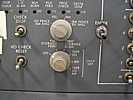
OK - which shilling operation mode should we set for. This is truely an *International* Business Machine ;-)) - Four of us worked 'till about 7.
- Thursday April 6th - 10 AM - Roll up sleeves -
Bob Feretich and Grant Saviers and ? were there - Should we call them the "Red Team"? or TAU Team ;-))
They are coming in on Thursdays to get clear access at the 1401 :-))
- Card repair:
The new transistors work in the Trigger cards. The card Ron Crane repaired worked in the system. We replaced the 2N1303 on a second card on Thursday. It works now too. We are still using the 2N1303s and 2N1309s in circuits where the slow speed is desired. - TAU Status:
Thursday, we were able to get the TAU to write bursts of data and write continuously to the Tape Channel. In continuous mode, writing would continue until we activated the Disconnect switch on the CE Panel. I don't know if all of the control sequencing is exactly as shown on the timing diagrams, but at first glance, it looks good.After several minutes of writing continuous data, the VRC check light turns on. I suspect this is another transistor "breakdown voltage" problem like the one we saw with the "64 bit" of the Delay Counter. So far, all TAU testing has been done from the CE Panel. The basic selection hand-shake seems to work for all models of 729 drives at all density settings. The Rewind, Rewind-and-Unload, Write, and Disconnect operations appear to be working.
- Tape Channel Analyzer Status:
The Analyzer has played a key role in permitting debug to proceed this far. We can continue to use it "as is" to build more confidence in the above operations. (I plan to use it in conjunction with the Logic Analyzer to create and verify interface and state timing diagrams.) We need to finish development of the Analog Board and PIC firmware to debug the Read and Backspace operations.We have succeeded in writing, assembling, linking, downloading, and running a "Hello World" program for the PIC. The PIC programmer we purchased was failing intermittently. Jeff Stutzman was able to repair it with a new programmer PIC chip and a bootloader he found on a Russian web site. We have learned quite a bit about the idiosyncrasies of the PIC firmware development environment.
We plan to continue TAU debug next Thursday.
Regards,
Bob Feretich
- Saturday April 8th - 10 AM - Roll up sleeves -
- Present were Ron Williams and Tim Coslet.
- Ron is working on the multiply instruction. Found a number of things that are working correctly, but the false Storage Address Register error of last Wednesday is still plaguing him. And, in any case, the numerical result is also bad :-((
- Wednesday April 12th - 10 AM - Roll up sleeves -
- Present were Allen Palmer, Grant Saviers, Glenn Lea, Brian Yee, Frank King, Chuck Kantman, Bill Flora, Robert Garner, Ron Williams, Ron Crane, Ed Thelen, with visits by John Toole, Bill Selmeier and Randy Neff
- Allen and Glenn removed the power supplies from the next two 729 tape drives to be rejuvenated. One is the second 729 Mod V called "Red Dot", as opposed to the just re-furbished "Green Dot". The dot business identifies the proper log books, parts, notes, ...
- I received a formal complaint about this web site fron Allen. ;-)) Allen feels that there is a lot more fun
and comradery than expressed in this column. He points out all the joking around that is not
adequately covered. And also the various things that Ron Williams has made to make our life easier.
Examples of Ron's happy influence are the two "IBM BLUE" "pulpits" for easier viewing of ALD and temporary setting of tools and parts,
and the high and low chairs - and humorous messages and the birds in the viewing room and ...
All true - but a lot of that would have to be caught on a web cam - the printed page is rather limited.
Robert Garner mentioned later "btw, web cams are nearly never humorous, but home movies are. :-) I/we need to start bringing my/our video recorders again! 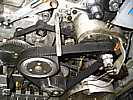
punch front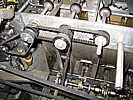
middle back
back of readerThere are lots and lots of belts in the 1402 reader punch - and they are not getting any younger!! - Frank King wishes a project calender, read/write accessable by project members, to reduce collisions when coming in to work on the 1401 (we are up to 2 days a week and the programmers aren't even involved yet). Bill Selmeier is good at this kind of setup and gave advice - which likely went over Ed Thelen's head - something about PHP and Apache and ...
- John Van Gardner - Atlanta, Ga. tells Customer Engineer stories.
He needs a picture or two to help
illustrate field fixing a printer buffer core stack - how to access it to fix it without sending back to the factory.
Here is a selection ;-))
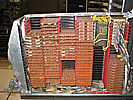
card side
card side bottom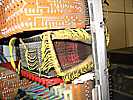
card side top
wire side top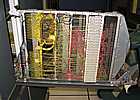
wire side
wire side detail - Ron Williams and Chuck Kantman found another bad card in the multiply logic. - Like it had a burned 20 ohm resistor. Ron Crane went to Halted for parts, and replaced the resistor and associated shorted transistor. Further testing next week.
- Randy Neff can get access to the museum's 12x17 inch scanner after hours, brings his own laptop to avoid password problems, and spent a few more hours scanning 1401 ALDs and other documents.
- Thursday April 13th - 10 AM - TAU Team -
- Saturday April 15th - 10 AM - extra day
- Present were Ron Williams and Ron Crane.
- Removed temp fix for False STAR errors - April 12
- Bad card at 02A7 - B12 - B-Aux Star Reset
- MPY now works !! :-))
- No error indications on divide, but didnt check answers, terrible paper work
- Wednesday April 19th - 10 AM - Roll up sleeves -
- Present were Grant Saviers, Don Cull, Tim Coslet, Glenn Lea, Bob Erickson Ron Williams, Allen Palmer, Bill Flora, Ed Thelen. (Robert Garner was absent with leave ;-))
- Allen Palmer and Glenn Lea removed clutches and motors from the next two 729 tape drives to be renewed :-))
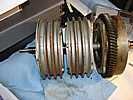
This is one of four clutch sets going to Grant's machine shop to have new felts washers, new magnetic powder, installed and general clean-up and tune-up. - Ron Williams, Bill Flora and Don Cull struggled with the 1401 which developed a case of "morning sickness" after working quite well the previous Saturday (See MYP works).
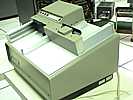
Brian Knittel's
card readera movie of Brian's card reading program in action 1.5 megabytes Lincoln Labs, MIT sent us a card deck labeled "Thermal Defocus". Bill Selmeier read the five inch card deck (using Brian's card reader) into his laptop. Ron Mak, who came later, said the deck was FORTRAN II. We will send the deck and results back to Lincoln Labs. - Bob Erickson worked on the 077 collator. The brushes and comparitors seem to be working!! Tim Coslet was key punching test decks :-))
- Thursday April 20th - 10 AM - TAU Team -
Bob Feretich, Jeff Stutzman, and Dave Alessio seem to have been present
Tape Channel Analyzer status:
The PIC programming problems have returned. We are currently unable to program the Analyzer's PIC. Our best guess is that the high programming voltage from the Programmer (above the PIC's maximum ratings by a few millivolts) has cooked the PIC. It would be nice to verify this, by attempting to program the PIC using a different programmer, but we have been unable to obtain use of an alternate programmer. (Eric can you help us here?)We analyzed the Programmer's schematic and determined that there is a design mistake that sends about 13.3 volts to the PIC. The PIC is supposed to be programmed using a voltage of 9 to 12 v, with 13.25v maximum. We have modified the Programmer to use 11.8v.
We observed the programming operation using the sampling storage scope. The programming signals look clean and the bit pattern samples appear valid.
Jeff will procure a replacement PIC module.
TAU debug status:
We verified the tape channel signal timings of CE Panel initiated tape write operations. At 556cpi density, we observed a block of 13 write strobe pulses (a record of 13 characters). Each pulse was about 1.5 uSec wide at a 24 uSec period. The "write check char" signal went inactive just before that first pulse and transitioned to active 96 uSec after the last write pulse. All of the above was within the envelope of the GO signal which became active 7.5 mSec before the first write pulse and inactive 3 mSec after the check character is written. These timings exactly match the documentation.We executed Tape Rewind and Tape Rewind&Unload instructions from the 1401. While debugging these instructions, we found an open diode. The effect of this bad diode was that the TAU would respond to non-tape instructions by interpreting data in the A-Reg as an action to be performed and, depending on this action, activating its BUSY signal back to the 1401. It is possible that this bug could have been confusing the overlap logic.
We are now able to loop Tape Rewind and Tape Rewind&Unload instructions in single cycle mode and at speed. (The Tape Analyzer immediately responds with "completion" of rewind requests.)
Our next objective is to perform a Tape Write instruction from the 1401. Once that works, we should attach the refurbished tape drive and see what happens.
Regards,
Bob Feretich
- Saturday April 22nd - 10 AM - Roll up sleeves -
- Present were Tim Coslet, Ron Williams, Ron Crane, Robert Garner, Ed Thelen.
- A box containing about 100 IBM transistors (maybe 20 big power transistors) had been delivered, addressed to Chuck Kantmann, from Bart Hancock. On the box was a notation "from San Jose Branch Office".

Jeff Stutzman (who stayed till noon) separated these out by type, and Ed Thelen labeled some drawers for them. - Ron Williams worked on the Overlap problem.
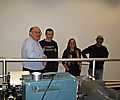
And of course we had visitors, these were just a few :-)) - Ron Crane and Ed Thelen continued testing and exercising the power supply from the "red dot" 729 mod V tape drive.
- Al Kossow talked with several of us about looking for pre-1975 software, in card or tape form.
- Wednesday April 26th - 10 AM - Roll up sleeves -
- Present (morning shift) were Ron Williams, Robert Garner, Allen Palmer, Glenn Lea, Frank King, Bob Erickson, Tim Coslet,
Bill Flora, Ed Thelen.
Afternoon shift included Ron Crane, Jeff Stutzman, Tim Coslet and Ed Thelen - - Bob Erickson (077 collator) found that the recent changes untimed the brushes. He retimed them, then found some unauthorized wiring changes in the comparitors (maybe to solve a local challenge?). He started making the machine more standard.
- Allen Palmer and Glenn Lea removed the power supplies from two of the remaining 729 tape drives for testing.
- Ron Williams, Frank King and Bill Flora fed lots of cards through the 1402 card reader - checking the instruction overlap problem?
- Tim Coslet and Ed Thelen resumed checking the power supplies for the "red" 729 mod V. We adjusted the voltages (some 15% off) and verified performance at partial and full rated loads. The + 6 volt regulator just would not hold a steady voltage - even under no load - the + 10 volts into the regulator was a lot more steady than the + 6 volts output which wavered up and down several tenths of a volt. We rotated the potentiometer that adjusted the voltage several times all the way in both directions to maybe clean it - but that did not seem to help. This pot is a two watt, 25 ohm unit not likely found at Radio Shack or Fry's.
- So we called Ron Crane who shortly showed up with Jeff Stutzmann. We took the back off the pot and rotated it some more. Ron went after the wire winding with fine emery cloth. No particular help - Are we barking up the wrong tree? After some joking about carbon tetrachloride, (now a no-no) we went after the pot with 1-1-1-2 tetrafloroethane (under the "Circuit Freeze" label ;-) ) and the voltage became rock solid. (Better than the others, but enough was enough - Ron said we gave the power supply system its 40 year tune up ;-))
- Can you imagine four 200 pound guys standing around glaring at a little 1.5 inch diameter 10 gram pot?
Then sandpapering its throat and bathing it in vile chemicals and what all - that pot did change its attitude !! ;-))
Just like the good old days when some of us were too poor or remote to get a new something, and wound up "re-manufacturing" the something to get it working again :-))
- Thursday April 27th - 10 AM - TAU Team -
from: Grant Saviers
re: "DP" Estate Donations [1401 _team] PDP-1 Thank youAll,
Many items from the estate were delivered to the museum on Thursday, including the scope, cart, and plug ins. Working with me were Ed Kramer, a close friend of Don's and former DEC & Thinking Machines executive, and Mike Miller, my ranch manager. Dave Dial, Julio, Ron Williams, Jeff Stutzman, and Bob Feretich were members of the unload team at the Museum.
I was busy with moving and setting up the new "workshop", also equipped with many items that were Don's and thus the additional loose scope plug-ins (everything that was requested was picked up) and the scope manuals may not be in the right place (including still being on my truck).
Please feel free to use these items and I will check Monday to see where the other parts are located, including the current probe.
The blue tape means that we powered up that unit and that it seemed ok. No detailed function or performance tests were performed, so be aware of the units potentially being out of calibration.
Ron Williams assembled the Vidmar cabinet drawers for storing 1401 spare modules and we moved it into the 1401 room. All 239 of the module types and total quantity should easily fit (although we forgot to configure a drawer for double wide modules). I will order some more dividers so each type has a labeled home. I am traveling next week and will not be in on Wed or Thurs.
I also suggested to Dave Dial that an inventory of CHM owned restoration equipment might be helpful to share some resources among restoration efforts. David is arranging for restoration volunteers to have access to the workshop. A few more workshop items are yet to be moved, probably in a few weeks.
Joe, thanks for the nice words, I will forward them to Sharon.
Regards,
Grant
joe_fredrick@att.net wrote:
Hi Grant ....
I was at the CHM Friday morning to help move the PDP-1 from the Restoration Lab to the Visible Storage Demo room and I saw the Tek scope cart with the items from the [DP] estate. Please express my heart felt thanks to Mrs [P] for this very kind offer. And thanks to you for arranging this. Several items were marked with blue masking tape .... these were the items I had asked for on behalf of the PDP-1 project ....
Tektronix TM 504 frame with four plug-ins,
DM 505 multimeter,
DC 503 universal counter,
AM 503 DC current probe,
PS 503 dual DC power supply.The Tektronix 7854 scope mainframe also had a blue-tape tag. May we use this item as well and could we have a set of vertical plug-ins and horizontal timebases ?
Finally, I looked for, but did not find the A6302 current probe that connects to the AM 503, but it is probably with the other items.
Thank you again for helping us out. These instruments will help us continue in our work to keep the IBM 1620 and PDP-1 machines running, and help in future CHM restoration projects.
..... joe fredrick
Tape Channel Analyzer Status:
Jeff and Dave Alessio each ordered and received the new Analyzer PIC modules. These modules are newer upward compatible versions of the one I originally ordered. The modules come with a crystal that makes them operate at 6 MIPS (compatible with the old module). The parts on the module are rated for higher speed operation, so Dave Alessio modified his to operate at 10 MIPS. If his proves stable at this speed, we will modify the other one also. The performance boost would give us better design margin in the interrupt services.Our old programmer was not successful in programming these new PICs. Previously, we were unsure whether our PIC module or Programmer was broken. We now know that the Programmer does not work. Jeff ordered a new and better programmer.
TAU Debug Progress:
We chased several red herrings yesterday. Several tests that we ran hung the 1401 CPU. Each diagnosis taught us a little more about CPU/TAU communication. Although we identified and fixed one hardware bug, generally, we believe that the observed results are correct machine operation.Using the Tape Analyzer, we were able to verify all critical interface timings of the Tape Write instruction. We were also able to loop these instructions at speed. Since the Analyzer does not yet have the ability to echo the write data, we needed to float a signal in the TAU to fool it into properly completing the write operation.
We are getting diminishing returns from our current test environment. I plan to come in next Wednesday (probably afternoon) to prepare for connecting the refurbished tape drive. We will need the long tape data cable from "invisible storage" to connect the drive.
Specific details of the major herring chases are in the logbook.
Regards,
Bob Feretich
